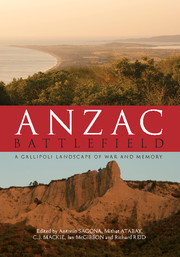Book contents
- Frontmatter
- Foreword
- Contents
- Figures
- Plates
- Contributors
- Acknowledgements
- Abbreviations
- Gallipoli battlefield place names
- Introduction
- 1 Boundary and divide: The antiquity of the Dardanelles
- 2 The Gallipoli campaign: History and legend
- 3 Recording the battlefield: First steps
- 4 Capturing the battlefield: Mapping and air photography at Gallipoli
- 5 Battlefield archaeology: Gallipoli
- 6 Forming the ANZAC battlefield
- 7 Forming the Ottoman battlefield
- 8 Artefacts from the battlefield
- 9 Remembering Gallipoli
- 10 Remembering Gallipoli from a Turkish perspective
- Conclusion
- Appendix Anzac Gallipoli Archaeological Database
- References
- Index
Conclusion
Published online by Cambridge University Press: 05 December 2015
- Frontmatter
- Foreword
- Contents
- Figures
- Plates
- Contributors
- Acknowledgements
- Abbreviations
- Gallipoli battlefield place names
- Introduction
- 1 Boundary and divide: The antiquity of the Dardanelles
- 2 The Gallipoli campaign: History and legend
- 3 Recording the battlefield: First steps
- 4 Capturing the battlefield: Mapping and air photography at Gallipoli
- 5 Battlefield archaeology: Gallipoli
- 6 Forming the ANZAC battlefield
- 7 Forming the Ottoman battlefield
- 8 Artefacts from the battlefield
- 9 Remembering Gallipoli
- 10 Remembering Gallipoli from a Turkish perspective
- Conclusion
- Appendix Anzac Gallipoli Archaeological Database
- References
- Index
Summary
After five years of field surveys, commencing in 2010, the Joint Historical and Archaeological Survey (JHAS) of the Anzac battlefield has now completed its work. This book is one product of the work that was done. The JHAS was the first systematic attempt in recent times to chart and record some of what has not weathered and eroded away of the Anzac battlefield a century after the fighting there ceased.
The only other archaeological survey conducted before the JHAS was that which accompanied the Gallipoli Peninsula Peace Park project. In the Foreword to the two-volume publication, the culmination of an international competition compiled by Raci Bademli, Suleyman Demirel, the then Turkish president, noted: ‘The Republic of Turkey, wishing to keep these legendary battles fresh in the memory of the future generations and to show that no war is cause for permanent hostilities, but can serve as a basis for friendships as well, has made the decision to turn the Battlefield of Gallipoli into a Memorial for World Peace.’
Since the 1915 campaign Turkey, Australia and New Zealand have been certainly drawn closer together with an increased mutual respect and understanding. Even so, and despite the immense value of the Peace Park publication, the fine-grained archaeological analysis of the Anzac battlefield had yet to be undertaken.
The Anzac site also has a history beyond the conflict itself. That story embraces the manner in which Turkey, Australia and New Zealand have woven different narratives of historical meaning and national symbolism around the experiences of their soldiers in that small area in 1915. The Ottoman Empire's virtual collapse in late 1918 initially allowed the Allies to place their interpretation of events, virtually unchallenged, on the old battlefields of Gallipoli. The creation of the ‘Anzac area’ meant that here was a part of Turkey that was not quite Turkey – sacred ground somewhat beyond that nation's full control, dedicated to the memory of the Allied dead who lay in its soil, both the missing and those with identified graves. With a couple of exceptions, Ottoman memorials marking their successful expulsion of the Allied armies at Anzac were destroyed.
- Type
- Chapter
- Information
- Anzac BattlefieldA Gallipoli Landscape of War and Memory, pp. 244 - 245Publisher: Cambridge University PressPrint publication year: 2016



